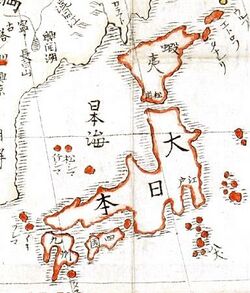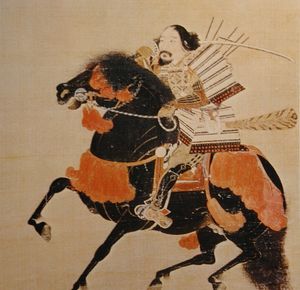فترة نانبوكو-چو
| جزء من سلسلة عن |
| تاريخ اليابان |
|---|
 |
فترة نانبوكو-چو (南北朝時代, Nanboku-chō jidai, "فترة البلاط الجنوبي والشمالي"، وتُعرف أيضاً بإسم فترة البلاطين الشمالي والجنوبي)، التي تمتد من 1334 إلى 1392، كانت فترة حدثت أثناء السنوات المشكـِّلة لـموروماتشي باكوفو في تاريخ اليابان.
During this period, there existed a Northern Imperial Court, established by Ashikaga Takauji in Kyoto, and a Southern Imperial Court, established by Emperor Go-Daigo in Yoshino.
Ideologically, the two courts fought for fifty years, with the South giving up to the North in 1392. However, in reality the Northern line was under the power of the Ashikaga shoguns and had little real independence.
Since the 19th century the Emperors of the Southern Imperial Court have been considered the legitimate Emperors of Japan. Other contributing factors were the Southern Court's control of the Japanese imperial regalia, and Kitabatake Chikafusa's work Jinnō Shōtōki, which legitimized the South's imperial court despite their defeat.
The consequences of events in this period continue to be influential in modern Japan's conventional view of the Tennō Seika (Emperor system). Under the influence of State Shinto, an Imperial decree dated March 3, 1911 established that the legitimate reigning monarchs of this period were the Southern Court.[1] After World War II, a series of pretenders, starting with Kumazawa Hiromichi, claimed descent from the Southern Court and challenged the legitimacy of the modern imperial line which is descended from the Northern Court.[2]
The destruction of the Kamakura shogunate of 1333 and the failure of the Kemmu Restoration in 1336 opened up a legitimacy crisis for the new shogunate.[3] Furthermore, institutional changes in the estate system (the shōen) that formed the bedrock of the income of nobles and warriors alike decisively altered the status of the various social groups. What emerged from the exigencies of the Nanboku-chō (Southern and Northern Court) War was the Muromachi regime, which broadened the economic base of the warriors while undercutting the noble proprietors, a trend that had started already with the Kamakura bakufu.
. . . . . . . . . . . . . . . . . . . . . . . . . . . . . . . . . . . . . . . . . . . . . . . . . . . . . . . . . . . . . . . . . . . . . . . . . . . . . . . . . . . . . . . . . . . . . . . . . . . . . . . . . . . . . . . . . . . . . . . . . . . . . . . . . . . . . . . . . . . . . . . . . . . . . . . . . . . . . . . . . . . . . . . .
سقوط باكوفو كاماكورا
قالب:Campaignbox Nanboku-chō Wars
استعادة كمـّو: 1333-1336
روابط التبعية وبزوع باكوفو مورُماتشي
بزوغ أمراء شوگو
حادث كانـّو و the resurgence of the Southern Court in the 1350s
أباطرة البلاط الجنوبي
- Emperor Go-Daigo 「後醍醐天皇」(1288–1339, r. 1318–1339)
- Emperor Go-Murakami 「後村上天皇」(1328–1368, r. 1339–1368))
- Emperor Chōkei 「長慶天皇」(1343–1394, r. 1368–1383)
- Emperor Go-Kameyama 「後亀山天皇」(1347–1424, r. 1383–1392)
أباطرة البلاط الشمالي
- Northern Ashikaga Pretender 1: Emperor Kōgon「光厳天皇」(1313–1364, r. 1331–1333)
- Northern Ashikaga Pretender 2: Emperor Kōmyō「光明天皇」(1322–1380, r. 1336–1348) *
- Northern Ashikaga Pretender 3: Emperor Sukō「崇光天皇」(1334–1398, r. 1348–1351)
- Interregnum, November 26, 1351 until September 25, 1352
- Northern Ashikaga Pretender 4: Emperor Go-Kōgon「後光厳天皇」(1338–1374, r. 1352–1371) *
- Northern Ashikaga Pretender 5: Emperor Go-En'yū「後円融天皇」(1359–1393, r. 1371–1382) *
الهامش
- a.^ Shugo (守護?) was a title, commonly translated as "Governor", given to certain officials in feudal Japan. They were each appointed by the shogun to oversee one or more of the provinces of Japan.
- b.^ The verb "to enfeoff" is defined by the Random House Dictionary of the English Language as:"1) to invest with a freehold estate in land" and 2) "to give as a fief".
- c.^ The story of Tadayoshi's alleged plot to assassinate Moronao is part of the Taiheiki.
الهامش
للاستزادة
- Arnesen, P.J. The Medieval Japanese Daimyo. New Haven: Yale University Press, 1979.
- Arnesen, P.J. "Provincial Vassals of the Muromachi Shoguns", in The Bakufu in Japanese History. Eds. Jeffrey P. Mass and William B. Hauser. Stanford: Stanford University Press, 1985.
- Brunner, G., "Legitimacy Doctrines and Legitimation Procedures in East European Systems." In Legitimation in Communist States. Ed. by T.H. Rigby and Ference Feber. New York: St. Martin's Press, 1982.
- Chan, H., Legitimation in Imperial China. Seattle: University of Washington Press, 1984.
- Elias, N. Power and Civility. Oxford: Basil Blackwell, 1982.
- Fenollosa, E. Epochs of Chinese & Japanese art: An outline history of East Asiatic design. Frederick A. Stokes, 1921
- Gay, S. "Muromachi Bakufu Rule in Kyoto: Administrative and Judicial Aspects", in The Bakufu in Japanese History. Eds. Jeffrey P. Mass and William B. Hauser. Stanford: Stanford University Press, 1985.
- Gay, S. "The Kawashima: Warrior-Peasants of Medieval Japan", in Harvard Journal of Asiatic Studies. 46 (June 1986), 81-119.
- Grossberg, K. Japan's Renaissance. Cambridge: Harvard University Press, 1981.
- Hall, John Whitney. Government and Local Power in Japan: 500-1700. Princeton: Princeton University Press, 1966.
- Harrington, L.F. "Regional Outposts of Muromachi Bakufu Rule: the Kanto and Kyushu", in The Bakufu in Japanese History. Eds. Jeffrey P. Mass and William B. Hauser. Stanford: Stanford University Press, 1985.
- Hori, K. "The Economic and Political Effects of the Mongol Wars", in Medieval Japan. Eds. John W. Hall and Jeffrey P. Mass. New Haven: Yale University Press, 1974.
- Kahane, R. Legitimation and Integration in Developing Societies. Boulder: Westview Press, 1982.
- Kawai, M. "Shogun and Shugo: the Provincial Aspects of Muromachi Politics", in Japan in the Muromachi Age. Eds. John W. Hall and Toyoda Takeshi. Berkeley: U.C. Press, 1977.
- Kierstead, T.E., "Fragmented Estates: the breakup of the Myo and the Decline of the Shoen System", in Monumenta Nipponica. 40 (Autumn 1985), 311-30.
- Lipset, S.M., "Social Conflict, Legitimacy, and Democracy." In Legitimacy and the State. Ed. by William Connolly. New York: New York University Press, 1984.
- Mass, Jeffrey P. "The Emergence of the Kamakura Bakufu", in Medieval Japan. Eds. John W. Hall and Jeffrey P. Mass. New Haven: Yale University Press, 1974.
- __________. "Jito Land Possession in the Thirteenth Century: The Case of Shitaji Chubun", in Medieval Japan. Eds. John W. Hall and Jeffrey P. Mass. New Haven: Yale University Press, 1974.
- __________. Lordship and Inheritance in Early Medieval Japan. Stanford: Stanford University Press, 1989.
- Mehl, Margaret. (1997). History and the State in Nineteenth-Century Japan.
- Miyagawa, M. "From Shoen to Chigyo: Proprietary Lordship and the Structure of Local Power", in Japan in the Muromachi Age. Eds. John W. Hall and Toyoda Takeshi. Berkeley: U.C. Press, 1977.
- Nagahara, K. "Village Communities and Daimyo Power", in Japan in the Muromachi Age. Eds. John W. Hall and Toyoda Takeshi. Berkeley: U.C. Press, 1977.
- Nagahara, K. "Shugo, Shugo Daimyo, Sengoku Daimyo", in Rekishi Koron, 8 (August 1982), 10-19.
- Papinot, Edmund. Historical and Geographical Dictionary of Japan. Tokyo: Tuttle, 1972.
- Sansom, George Bailey. A History of Japan: 1334-1615. Stanford: Stanford University Press, 1961.
- Sato, S. "The Ashikaga Shogun and the Muromachi Bakufu Administration", in Japan in the Muromachi Age. Eds. John W. Hall and Toyoda Takeshi. Berkeley: U.C. Press, 1977.
- Tanuma, M. "Muromachi Bakufu, Shugo, Kokujin", in Muromachi Bakufu. Nihon Rekishi, vol. 7. Tokyo: Iwanami Shoten, 1976.
- Varley, H. Paul. The Onin War. New York: Columbia University Press, 1967.
- __________. Imperial Restoration in Medieval Japan. New York: Columbia University Press, 1971.
- Wintersteen, P.B. "The Muromachi Shugo and Hanzei", in Medieval Japan. Ed. John W. Hall and Jeffrey P. Mass. New Haven: Yale University Press, 1974.
- Wintersteen, P.B. "The Early Muromachi Bakufu in Kyoto", in Medieval Japan. Ed. John W. Hall and Jeffrey P. Mass. New Haven: Yale University Press, 1974.
- Weber, M. Economy and Society v.I. Berkeley: University of California Press, 1968.
- Yamamura, K. "The Cambridge History of Japan, Volume 3": Cambridge: Cambridge University Press, 1990.
هذه الفترة تتألف من الجزء المبكر في فترة موروماتشي من تاريخ اليابان.


